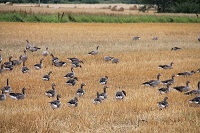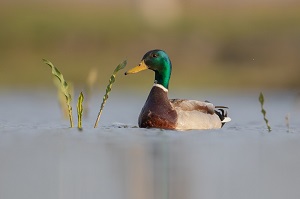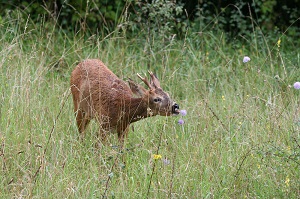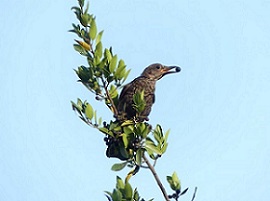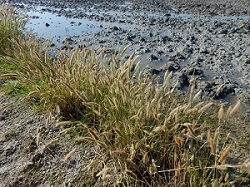- The study led by the CSIC confirms that greylag geese spread several plant species between different habitats 300 kilometres from their origin.
- Scientists have analyzed faecal samples and the movements of this species marked with GPS for the research carried out in Sweden.
Waterfowls play an essential role in dispersing seeds of native and exotic plants and weeds connecting agricultural habitats and terrestrial and aquatic ecosystems and leading to environmental and economic impacts that may be unnoticed until now. These are the results of a new study led by the Estación Biológica de Doñana (EBD-CSIC), of the Spanish National Research Council (CSIC) and published in the journal Agriculture, Ecosystems & Environment.
To conduct this research, the scientists selected the greylag goose as the study species. Their populations are increasing in northern Europe and often cause conflicts in agriculture by reducing the yield of cereal crops and pastures. During the study, they combined the analysis of faecal samples collected from a total of seven different habitats frequented by these species with GPS tracking of the birds. The aim was to find out, in addition to the seed dispersal capacity of these species, the habitats in which they disperse seeds and the distances and trajectories.
A total of 300 droppings collected from different locations in southern Sweden were analyzed, founding 41 different plant species from 19 different families, including the herbicide-resistant alien Conyza canadensis. Eleven of these species were agricultural weeds, including Chenopodium album and Stellaria media, two of the most problematic species for agriculture in Sweden, with documented herbicide resistance, that are common in the study areas.
"The networks we have developed based on GPS tagging suggest an important connectivity role for greylag geese in agricultural landscapes, with possible implications for the spread of exotic plants and weeds, and for dispersal across the land-water interface," explains María José Navarro, pre-doctoral researcher at the EBD-CSIC and lead author of the study. And not only for seed dispersal, these findings also suggest that they could be spreading microbes and invertebrates, as well as nutrients.
100,000 seeds dispersed per day in the study area
The results confirm that greylag geese connect agricultural habitats through daily flights, potentially spreading agricultural weeds between crop fields, but also connect aquatic and terrestrial ecosystems through local or long-distance movements. According to GPS data collected, geese moved daily from roosting areas, usually islands, lakes and wetlands, to feeding sites in agricultural fields, covering average distances of seven kilometres per day. The most affected areas were precisely those agricultural areas that were close to aquatic ecosystems, as they were more frequented by geese.
Taking into account the abundance of seeds observed in the droppings and the number of geese, approximately 100,000 seeds were dispersed daily by geese in the approximately 400 km2 study area in Sweden. In addition, GPS-tagged geese also occasionally flew non-stop between the two study areas, separated by 300 km, and likely dispersed seeds between them.
"With this study, we confirm that waterfowls act as seed dispersers in aquatic and terrestrial ecosystems, allowing plants to reach new habitats through their movements," says the researcher. Despite their importance, their role in seed dispersal has been less studied compared to other animal species. This research will help predict how plant species can, thanks to waterfowls, adapt to habitat destruction, changes in land use, climate change, or, alternatively, how alien species and weeds will spread.
Reference:
Navarro-Ramos, M.J., van Leeuwen, C. H., Olsson, C., Elmberg, J., Månsson, J., Martín-Vélez, V., Lovas-Kiss, A. & Green, A. J. (2024). Seed dispersal between aquatic and agricultural habitats by greylag geese. Agriculture, Ecosystems & Environment. DOI: 10.1016/j.agee.2023.108741
Communication
Estación Biológica de Doñana- CSIC


 Un estudio concluye que las aves acuáticas dispersan malas hierbas y plantas exóticas en cultivos y humedales
Un estudio concluye que las aves acuáticas dispersan malas hierbas y plantas exóticas en cultivos y humedales